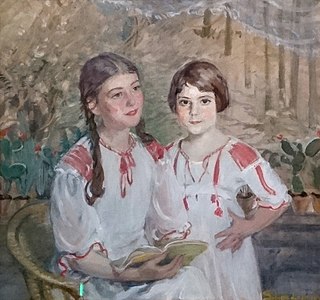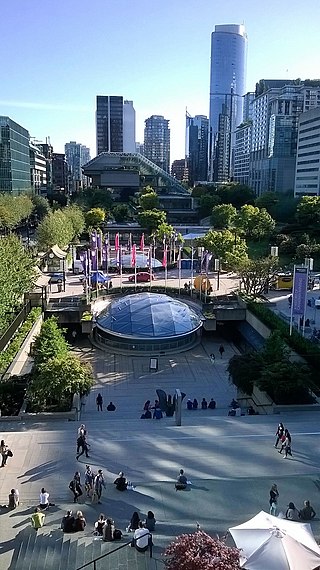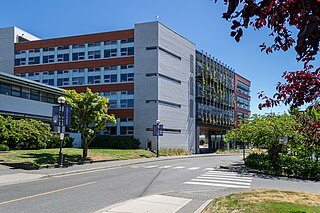
The University of British Columbia (UBC) is a public research university with campuses near Vancouver and Okanagan, in British Columbia, Canada. Established in 1908, it is the oldest university in British Columbia. With an annual research budget of $747.3 million, UBC funds 9,675 projects annually in various fields of study within the industrial sector, as well as governmental and non-governmental organizations.
Arthur Charles Erickson was a Canadian architect and urban planner. He studied at the University of British Columbia and, in 1950, received his B.Arch. (Honours) from McGill University. He is known as Canada's most influential architect and was the only Canadian architect to win the American Institute of Architects AIA Gold Medal. When told of Erickson's award, Philip Johnson said, "Arthur Erickson is by far the greatest architect in Canada, and he may be the greatest on this continent."

The UBC Botanical Garden is a botanical garden located on the University of British Columbia campus in Vancouver, British Columbia. It aims to maintain a documented living collection of temperate plants for the purposes of education, research, conservation, community outreach, and public display. Established in 1916, it is the oldest botanical garden at a university in Canada.

Jim Green was an American-Canadian who was a longshoreman, taxicab driver, community activist, non-profit housing developer, municipal politician, university instructor and development consultant.

Cornelia Hahn Oberlander LL.D. was a German-born Canadian landscape architect. Her firm, Cornelia Hahn Oberlander Landscape Architects, was founded in 1953, when she moved to Vancouver.
H. Peter Oberlander, was a Canadian architect and Canada's first professor of Urban and Regional Planning.
The Institute of Asian Research (IAR) is a research institute founded in 1978 at the University of British Columbia (UBC). The institute conducts interdisciplinary research and teaching on multiple South Asian and East Asian nations.

Robson Square is a landmark civic centre and public plaza, located in Downtown Vancouver, British Columbia. It is the site of the Provincial Law Courts, UBC Robson Square, government office buildings, and public space connecting the newer development to the Vancouver Art Gallery.
BNIM is an architecture and design firm founded in 1970 in Kansas City, Missouri.

The Beaty Biodiversity Museum is a natural history museum in Vancouver, British Columbia, Canada, located on the campus of the University of British Columbia. Its 20,000 square feet of collections and exhibit space were first opened to the public on October 16, 2010; since then it has received over 35,000 visitors per year.

The Law Courts building is part of the landmark Robson Square complex in downtown Vancouver, British Columbia, Canada. It was designed by renowned Canadian architect Arthur Erickson. The Law Courts building occupies the southern block of the three city block complex, provincial government offices the middle block, and the Vancouver Art Gallery the northern block. The building is used exclusively by the two higher courts of the Province of British Columbia: the Supreme Court and the Court of Appeal.

The Centre for Interactive Research on Sustainability (CIRS) is located at the University of British Columbia's (UBC) Point Grey Campus in Vancouver. The building is dedicated to research collaboration and outreach on urban sustainability. It was officially opened in November 2011.

The architecture of Vancouver and the Greater Vancouver area consists of a variety of modern architectural styles, such as the 20th-century Edwardian and the 21st-century modernist styles. Initially, the city architects embraced styles developed in Europe and the United States, with only limited local variation.
VIA Vancouver Institute for the Americas (1998–2007) was a Canadian organization of higher education, that operated under the umbrella of the UBC Faculty of Education, University of British Columbia, dedicated to the research and projects implementation of education for sustainable development centered in the academic integration of the Americas, under the guidance of the International Bureau of Education.
VIA operated from their main training center located at 470 Granville Street, Vancouver, in the province of British Columbia, and from their southern regional training center located at Las Condes, in Santiago, Chile. VIA was an organization incorporated in British Columbia, with a subsidiary registered in Santiago. VIA was an institute registered at the Ministry of Advanced Education of British Columbia as a provider of higher private education, allowing to provide accredited certifications and its programs qualified for provincial financial assistance and Canadian government scholarship programs.
Ann Dale is a researcher, public advocate and environmental policy analyst. She is known for her research on community sustainability.
Peter Busby is an architect and Managing Director at Perkins & Will Architects, with a background in philosophy and a history of advancing sustainable design. Throughout his career, he has advocated for sustainable building strategies and integrated green building infrastructure that serves to educate the users of his spaces.
Eva Matsuzaki is a retired architect and first former female president of the Royal Architectural Institute of Canada (RAIC). Eva immigrated from Latvia to the United States and later developed her career living in Vancouver, Canada. In 1998, she established her own firm known as Matsuzaki Architects Incorporated along with her husband, Kiyoshi Matsuzaki. Matsuzaki is a founding member of Vancouver's women in architecture support network and is involved in environmentally sensitive and sustainable building design.
Alfred V. Waugh is an Indigenous architect based in British Columbia. Born in Yellowknife, Waugh studied Urban and Regional Studies as an undergraduate at the University of Lethbridge, and pursued a second bachelors degree in architecture at the University of British Columbia School of Architecture. Waugh founded Formline Architecture + Urbanism in 2005, an Indigenous-owned practice. He is best known for the design of the Indian Residential School History, and Dialogue Centre at the University of British Columbia, designed alongside Manny Trinca and Vince Knudsen. Another notable project is the First Peoples House at the University of Victoria, which he designed in collaboration with Kenneth Wong.














